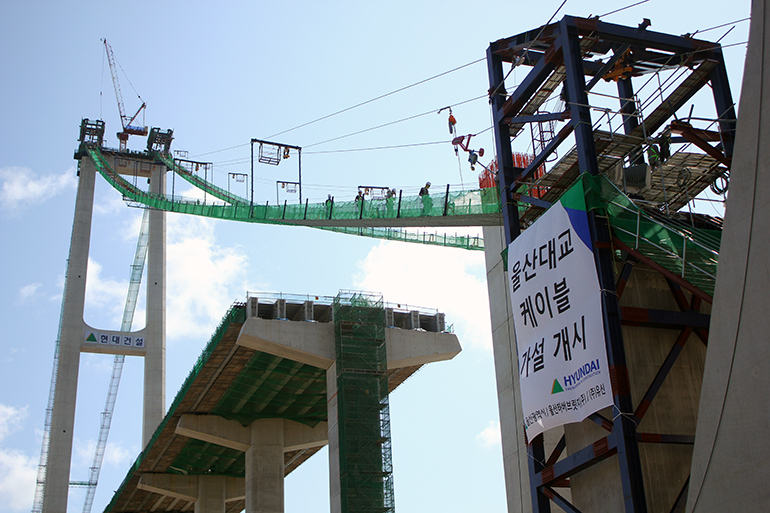-
Business & Technology
Business &
Technology -
Investment & Value
Invest &
Value -
People & Career
People & Career
- Hyundai E&C
Ulsan Grand Bridge
- Republic of Korea / Ulsan
- KRW 392,165,090,909
- completion on Mar. 2017
New landmark in Ulsan
The Ulsan Bridge is considered a masterpiece in which the capability of Hyundai E&C has reached an unprecedented level in suspension bridge construction since the Namhae Bridge. The large-scale project is to construct an 8,380-meter bridge with two to four lanes connecting Maeam-dong in Nam-gu and Ilsan-dong in Dong-gu, in Ulsan. The single-span suspension bridge has a 1,150-meter-long span between towers, the world’s third longest central span between two pylons followed by the Runyang Yangtze River Bridge (1,400 meters) and the Jiangyin Yangtze River Bridge (1,300 meters), and two times longer than the Gwangan Bridge in Busan. The application of wind and earthquake resistant designs enables the bridge to withstand strong winds of 80 meters per second and earthquakes of magnitude 7.0. Two towers 203 meters high were built in the southern district of the city (Nam-gu) and the eastern district (Dong-gu), respectively.
The construction of the Ulsan Bridge and its access road contributes to solving chronic traffic congestions in the Asan Road and the Bangeojin Beltway resulting from an increase in traffic volume due to a lack of roads connecting the eastern part and the western part of the city. The new, shortest route linking Nam-gu with Dong-gu plays an important role in establishing a “marine tourism belt,” promoting balanced city development, and improving the freight transport system.
Korea’s first PPWS method
Hyundai E&C introduced brand new construction methods based on its own technologies to the entire construction process ranging from cable manufacturing to construction.
Ultra-high strength cables of 1960 MPa were used for the first time in the world. PPWS (Prefabricated Parallel Wire Strand) method was employed, the first of its kinds in the country. In the PPWS method, 127 high-strength steel wires with diameters of 5.4 mm are bundled with tape at a regular interval, consisting of cables of suspension bridges. The PPWS method can guarantee shorter construction periods and greater construction quality, compared to the existing A/S (Air Spinning) method.

Cutting-edge equipment of Hyundai E&C includes a driving winch which can freely move on a long-span suspension bridge with a two-kilometer-long span between towers and reel in and out cables. The operation room aimed to control the entire construction in an integrated way, and the image monitoring equipment mounted along the cable installation route to identify the work status maximized the efficiency and safety of the bridge construction, significantly improving the capability of the builder in suspension bridge construction.
Moreover, the Ulsan Bridge project made use of a tunnel-type anchorage for the first time in the domestic construction industry. A bridge anchorage refers to a concrete structure attached to the end of a suspension bridge. As the anchorage structure of the Ulsan Bridge had to be constructed on the steep slope of Yeomposan Mountain, Hyundai E&C took such geographical features into consideration and strove to minimize damages to the natural environment. To put a priority on a harmony between bridge construction and the surrounding environment, the builder introduced the tunnel-type anchorage system in which it drilled a 70-meter inclined shaft, built a post-tensioned anchorage frame and filled them with concrete.


